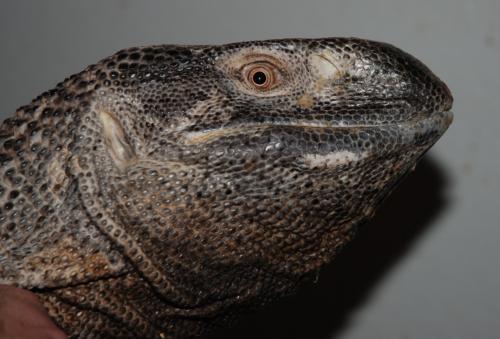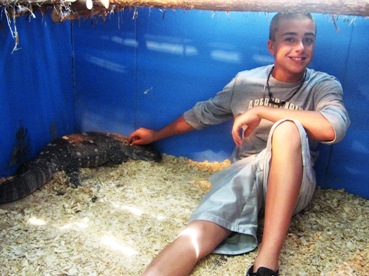|
Black
Throated Monitor

Black Throated Monitors are
semi arboreal lizards, yet spend half of their time
underground in burrows, or searching the ground for prey.
They are well known by African bird watchers as the most
prevalent predator on nesting birds, and song birds, they
will in fact set an ambush next to a nest of eggs or chicks
to await the return of the parents, eat both parents then
the eggs or chicks. They are also known for living in large
rock piles hence the name "rock or tree leguaan. They are
greatly adapted diggers and can burrow like a highly skilled
team of miners in hard packed dirt. (This information was
taken from
repticzone.com/)
We have one Black Throated Monitor at Cub
Creek Science and Animal Camp. His name is Vulture, and
he is by far our largest lizard. We got vulture when
he was just a hatchling and he is now much larger than our
adult green iguana.
Vulture has his own room that he shares with
a Savannah Monitor and an adult Green Iguana.
We purchased a baby Black Throated Monitor
about three years ago from
Pro Exotics and couldn't have
been more pleased with the lizard or their service.
All of the pictures of the Black Throated Monitor are of
this same baby (all grown up). Below is the care sheet
of the Black Throated Monitor Lizard from there web site.
-also applies to White Throat and Savannah
Monitors
Day temps- 80-85 degrees F with
130F+ elevated basking spot
Night temps- 72-80 degrees F
Setup- Husbandry is “typical
Monitor” setup. A good diggable, burrowable soil is the
best substrate choice, cypress mulch a distant second.
We suggest smaller cages for babies, for a better sense
of security. A good hot spot/basking spot is extremely
important, but so is a proper ambient temperature. Have
a Temp Gun handy, and know how to use it. Small, tight
hide spots, good sized water dish, soil substrate is
kept moderately moistened, moderately high cage
humidity.
Basking Spot- We use wide
basking spots to provide temp gradients up to 130°F or
more. Elevated basking spots allow us to achieve proper
temps using
50 watt Halogen flood bulbs. Proper temp
gradients also allow for multiple moisture levels
without any problems. We use no UVB or full spectrum
lighting at all.
Daily care- Keep substrate moistened
as necessary. It should be moist at depth, but not wet
at any level. Spot clean as necessary.
Feeding- We feed baby and juvie
monitors 6 days a week. Four days on feeder insects
(roaches are a favorite and easy to work with) and two days
on thawed rodents. Adults get fed according to need and
body weight.
Notes- Read our entire FAQ for more
detailed discussion of MANY husbandry topics that can
benefit your setups and animals. Monitor care is quite
consistent across the board. You can keep many monitor
species using the same basic monitor husbandry theory
and strategies. Monitors need a wide temp gradient,
proper hydration, and a proven, nutritious diet.
 More
information
on the Black Throated Monitor
|






The Black Throated Monitor is on the bottom and our Savannah
Monitor, Natasha, is on the top. The Black Throated
Monitor, Vulture, is a much larger lizard. |